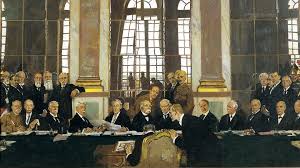“Versailles Conference and Peace Settlement” – Everything You Need to Know
The end of World War I marked a pivotal moment in global history, and at its heart lay the Versailles Conference—a monumental gathering of world leaders whose decisions would reshape international relations for decades to come. In this comprehensive guide on Versailles Conference and Peace Settlement, we delve into the origins, key events, major players, and lasting consequences of the peace settlement that not only ended a devastating war but also laid the groundwork for future conflicts and international cooperation.
Introduction: A Turning Point in Global History
Imagine a conference where the fate of millions was decided in a grand hall filled with diplomats, generals, and political titans. Did you know that the Treaty of Versailles, signed in 1919 at the culmination of the Versailles Conference, imposed such severe terms on Germany that many historians consider it a primary catalyst for World War II? In this post on Versailles Conference and Peace Settlement, we will explore:
- A clear definition of the Versailles Conference and Peace Settlement, including its essential characteristics.
- The historical and contextual background that led to the conference and shaped its outcomes.
- An in-depth exploration of key issues—territorial adjustments, war reparations, the war guilt clause, and the creation of the League of Nations.
- Real-world examples and case studies illustrating the methods of diplomatic negotiation and their consequences.
- The significance of the peace settlement for global politics, culture, and international law.
- Common misconceptions and frequently asked questions to clear up persistent myths.
- Modern relevance and current debates surrounding the legacy of the Treaty of Versailles.
- A call-to-action encouraging further exploration and discussion about how these historical decisions continue to impact our world today.
Understanding Versailles Conference and Peace Settlement is crucial not only for grasping the end of World War I but also for appreciating its enduring influence on global affairs, international law, and the balance of power in our modern world.
What Is the Versailles Conference and Peace Settlement?
Defining the Concept
The Versailles Conference and Peace Settlement refers to the series of negotiations and agreements that took place primarily in 1919 following the end of World War I. Convened at the Palace of Versailles near Paris, the conference brought together representatives from the victorious Allied Powers—most notably, the United States, the United Kingdom, France, and Italy—to negotiate a peace settlement with the defeated Central Powers, especially Germany.
Key Characteristics:
Diplomatic Negotiations:
The conference was marked by intense diplomatic discussions aimed at redrawing the map of Europe, establishing war reparations, and determining the future political structure of the defeated nations.Territorial Adjustments:
The settlement involved significant redrawing of national boundaries, including the loss of territories by Germany and the dissolution of multi-national empires such as Austro-Hungary and the Ottoman Empire.War Guilt Clause and Reparations:
A central and controversial aspect of the treaty was the assignment of full responsibility for the war to Germany, which led to the imposition of severe financial reparations and punitive measures.Creation of International Institutions:
The conference led to the establishment of the League of Nations, an international organization designed to maintain peace and prevent future conflicts.Mixed Outcomes:
While intended to secure lasting peace, the harsh terms and perceived injustices of the settlement sowed the seeds of future conflicts, contributing to the geopolitical tensions that ultimately culminated in World War II.
By understanding these essential features, we see that the Versailles Conference and Peace Settlement was not merely a conclusion to a war, but a transformative event with long-lasting global implications.
Historical and Contextual Background
The Road to Versailles
Before the Versailles Conference, Europe was left devastated by World War I—a conflict marked by unprecedented destruction, loss of life, and political upheaval. Several key factors and events paved the way for the peace negotiations:
1. The Catastrophe of World War I
Unprecedented Scale of Destruction:
World War I resulted in the mobilization of over 70 million military personnel and the deaths of approximately 17 million people. The extensive trench warfare, use of chemical weapons, and technological innovations in combat created a conflict of unparalleled brutality.Political and Economic Ruin:
The war left many European nations economically weakened and politically unstable. Empires that had once dominated the continent, such as the Austro-Hungarian, Ottoman, Russian, and German Empires, were in decline or collapse.
2. The Desire for a New International Order
Calls for Peace and Stability:
The horrors of the war spurred a global desire for peace and a commitment to prevent such a conflict from happening again. This sentiment was a driving force behind the creation of new international institutions.Influential Voices:
Leaders such as U.S. President Woodrow Wilson, with his Fourteen Points, advocated for a transparent and fair peace settlement. Wilson’s vision emphasized self-determination, open diplomacy, and the establishment of a League of Nations.
3. Milestones Leading to the Conference
Armistice of November 11, 1918:
The signing of the armistice brought an end to hostilities on the Western Front, creating an urgent need to negotiate a comprehensive peace settlement.Preliminary Peace Talks:
Before the formal conference, preliminary discussions and negotiations took place among the Allied Powers to outline their goals and set the agenda for the upcoming talks.
Notable Anecdotes
The Tense Atmosphere in Versailles:
The palace of Versailles, with its opulent halls and historical significance, provided a symbolic backdrop for the negotiations. The stark contrast between the lavish surroundings and the grim realities of war underscored the magnitude of the decisions being made.Key Personalities:
Figures like Georges Clemenceau of France, David Lloyd George of Britain, and Woodrow Wilson of the United States played pivotal roles. Their differing visions and priorities set the stage for both cooperation and conflict during the negotiations.
In-Depth Exploration / Main Body
To thoroughly understand The Russian Revolution and Its Effects, we now break down the key aspects of the Versailles Conference and its broader peace settlement into detailed sections.
1. Diplomatic Negotiations and Political Dynamics
a. The Major Players and Their Agendas
United States – Woodrow Wilson:
Wilson entered the conference with a set of idealistic principles encapsulated in his Fourteen Points, emphasizing self-determination, open diplomacy, and the creation of a League of Nations. His vision aimed at a fair and lasting peace, though it often clashed with the more pragmatic and punitive approaches of European leaders.France – Georges Clemenceau:
Clemenceau, known as “The Tiger,” was determined to ensure that France would never be threatened by Germany again. His approach was marked by a desire for strict punitive measures against Germany, including significant reparations and territorial concessions.Britain – David Lloyd George:
Lloyd George sought a balance between punishment and reconciliation. While he recognized the need for reparations to rebuild Britain’s economy, he was also mindful of the risks of excessively harsh terms that could destabilize Europe.Italy – Vittorio Orlando:
Italy’s participation was driven by ambitions for territorial expansion and recognition of its contributions to the war. However, Italy’s goals were not fully met, leading to dissatisfaction and setting the stage for future domestic unrest.
b. The Negotiation Process
Key Negotiations:
The negotiations were characterized by intense debates over key issues such as territorial adjustments, reparations, and the establishment of new international institutions. The process was often contentious, with each nation defending its national interests.Diplomatic Tensions:
The divergent priorities of the major powers led to significant diplomatic friction. For example, Wilson’s insistence on a “just peace” clashed with Clemenceau’s demand for severe punishment, illustrating the inherent challenges in reconciling idealism with pragmatism.Treaty of Versailles:
The culmination of these negotiations was the Treaty of Versailles, signed on June 28, 1919. The treaty imposed harsh penalties on Germany, including substantial reparations, territorial losses, and strict limitations on its military capabilities.
2. Key Components of the Peace Settlement
a. Territorial Redistributions
Redrawing Borders:
One of the most visible outcomes of the Versailles Conference was the redrawing of national borders. The treaty dissolved empires and created new nation-states, reshaping the geopolitical landscape of Europe.Impact on Germany:
Germany was forced to cede territories to France, Belgium, and Poland. The loss of significant territories not only reduced its military capacity but also fostered a sense of national humiliation that would have lasting political consequences.Creation of New States:
The conference led to the establishment of new countries such as Czechoslovakia and Yugoslavia, as well as the reconfiguration of existing nations. These changes were intended to reflect the self-determination of various ethnic and national groups, though they also sowed the seeds for future conflicts.
b. War Guilt and Reparations
The War Guilt Clause:
Article 231 of the Treaty of Versailles, commonly known as the War Guilt Clause, placed full responsibility for the war on Germany. This clause served as the legal basis for demanding reparations.Financial Reparations:
Germany was required to pay massive reparations to the Allied nations. The economic burden imposed by these reparations contributed to widespread financial instability and resentment in Germany, setting the stage for future political extremism.Long-Term Economic Consequences:
The economic strains caused by reparations had far-reaching implications, contributing to hyperinflation and economic depression in the 1920s, and indirectly influencing the rise of extremist political movements.
c. Military Restrictions and Security Measures
Demilitarization of Germany:
The treaty imposed severe restrictions on Germany’s military capabilities, limiting the size of its army and prohibiting the development of an air force and submarines.Security Guarantees:
The establishment of international institutions, most notably the League of Nations, was intended to provide a framework for collective security and conflict resolution, aiming to prevent future wars.Controversial Outcomes:
Although these measures were designed to ensure long-term peace, the harsh military restrictions contributed to a sense of vulnerability and national resentment in Germany, which later played a role in the outbreak of World War II.
3. Social and Cultural Impact
a. Shaping National Identities
Sense of Humiliation and Resentment:
The punitive measures imposed on Germany had a profound impact on its national psyche. The collective memory of humiliation and injustice fueled nationalist sentiments and laid the ideological groundwork for future political extremism.Transformation of Allied Nations:
The peace settlement also reshaped the national identities of victorious countries. For example, France emerged with a renewed sense of determination to safeguard its future, while Britain grappled with balancing reparation demands and maintaining global influence.
b. Intellectual and Cultural Reactions
Debates on Justice and Peace:
The harsh terms of the Treaty of Versailles sparked widespread debate among intellectuals, politicians, and the public. The tension between the ideal of a “just peace” and the practicalities of punitive measures continues to be a subject of scholarly discussion.Cultural Reflections:
Literature, art, and cinema have all grappled with the legacy of the Versailles Treaty. Works of literature and film have explored themes of loss, humiliation, and the quest for redemption, reflecting the deep cultural scars left by the peace settlement.
4. Long-Term Global Consequences
a. Impact on International Relations
Precursor to Future Conflicts:
The Treaty of Versailles is widely regarded as a contributing factor to World War II. The economic and political instability it generated in Germany, combined with the punitive terms imposed, created fertile ground for the rise of extremist ideologies.Shaping the Post-War Order:
Despite its flaws, the treaty also laid the foundations for the modern international system. The establishment of the League of Nations, although ultimately ineffective, represented a pioneering effort to create a forum for international cooperation and conflict resolution.Global Diplomatic Lessons:
The diplomatic negotiations at Versailles have had a lasting impact on how international treaties are crafted. The importance of fairness, transparency, and inclusive dialogue in peace settlements remains a critical lesson for modern diplomacy.
b. Economic and Social Legacies
Economic Repercussions:
The financial burdens imposed on Germany had long-term economic consequences that influenced global economic policy in the interwar period and beyond.Social and Cultural Shifts:
The reshaping of national borders and the creation of new states altered the cultural and social fabric of Europe. These changes have continued to influence regional identities and international relations well into the 21st century.
Importance, Applications, and Benefits
Understanding The Versailles Conference and Peace Settlement is crucial for several reasons:
a. Informing Modern Diplomacy and International Law
Policy and Peacebuilding:
The lessons learned from Versailles inform modern diplomatic efforts and conflict resolution strategies. Studying the successes and failures of the treaty helps policymakers design more effective peace settlements.International Institutions:
The establishment of the League of Nations—and its successor, the United Nations—was directly inspired by the Versailles experience. These institutions continue to play a vital role in global governance and conflict prevention.
b. Enhancing Historical Literacy and Civic Engagement
Public Understanding:
A deeper understanding of how and why the Treaty of Versailles was crafted fosters a more informed citizenry. This knowledge is essential for engaging in meaningful debates about international policy and global justice.Educational Value:
Integrating the study of Versailles into educational curricula enriches students’ understanding of history, diplomacy, and the complexities of global politics.
c. Economic and Social Development
Economic Lessons:
The economic repercussions of the treaty, including the challenges of reparations and post-war recovery, offer valuable insights for modern economic policy and international financial regulation.Social Justice:
Understanding the social impacts of the treaty—such as the sense of national humiliation in Germany—provides context for modern discussions on nationalism, identity, and social equity.
d. Global Relevance and Future Insights
Historical Parallels:
The diplomatic and economic challenges of the Versailles era have echoes in contemporary international relations. Learning from this period can help leaders navigate current global conflicts and economic crises.Predictive Value:
By studying the factors that led to the treaty’s controversial outcomes, policymakers and scholars can better anticipate and address future challenges in conflict resolution and global governance.
Addressing Common Misconceptions and FAQs
Despite extensive research, several misconceptions about The Versailles Conference and Peace Settlement persist. Below are some frequently asked questions along with clarifications:
FAQ 1: Was the Treaty of Versailles solely to blame for World War II?
- Misconception:
Many critics argue that the treaty’s harsh terms were the only cause of World War II. - Reality:
While the treaty contributed to significant economic and political instability in Germany, it was one of many factors—including ideological extremism, economic conditions, and geopolitical rivalries—that led to the outbreak of World War II.
FAQ 2: Did the Versailles Conference achieve a “just peace”?
- Misconception:
Some believe that the treaty was entirely fair and successful in preventing future conflict. - Reality:
The treaty was deeply flawed; its punitive measures fostered resentment and economic hardship. While it aimed to ensure lasting peace, many of its terms inadvertently set the stage for future instability.
FAQ 3: Was the conference a completely unified effort among the Allies?
- Misconception:
It is often assumed that all Allied powers were in full agreement during the negotiations. - Reality:
In reality, the major Allied leaders—such as Woodrow Wilson, Georges Clemenceau, and David Lloyd George—had differing visions and priorities, leading to compromises that left many issues unresolved.
FAQ 4: Is the legacy of the Versailles Treaty irrelevant to modern international relations?
- Misconception:
Some claim that because the treaty was signed over a century ago, its lessons have no bearing on today’s world. - Reality:
The diplomatic strategies and institutional frameworks developed in the aftermath of the treaty continue to influence modern international law, diplomacy, and global governance.
Modern Relevance and Current Trends
a. Shaping Contemporary Diplomatic Practices
Peace Negotiations:
The experiences and challenges of the Versailles Conference inform modern peace negotiations and conflict resolution efforts. Understanding its successes and failures provides valuable lessons for crafting fair and sustainable peace agreements.International Institutions:
The evolution of global institutions, such as the United Nations, reflects the ongoing influence of the Versailles era. These organizations strive to promote dialogue and cooperation, learning from the diplomatic challenges of the past.
b. Economic Policy and Global Trade
Reparations and Economic Recovery:
The economic lessons of the treaty—particularly the dangers of punitive reparations—remain relevant as governments work to balance economic justice with sustainable growth in the aftermath of conflict.Global Economic Stability:
Modern economic policies continue to grapple with issues of trade, resource allocation, and financial regulation, echoing the economic debates that emerged from the Versailles settlement.
c. Social and Cultural Implications
National Identity and Historical Memory:
The cultural legacy of the Versailles Treaty—how it is remembered and taught—continues to shape national identities and international perceptions. Public commemorations and historical debates help keep the conversation about its legacy alive.Impact on Modern Ideologies:
The treaty’s controversial nature has influenced contemporary discussions on nationalism, social justice, and the responsibilities of global leadership.
d. Preparing for Future Global Challenges
Lessons in Diplomacy:
As the world faces new challenges—from cyber warfare to climate change—the diplomatic lessons learned from the Versailles era remain instructive. Understanding how past treaties have succeeded or failed can guide modern efforts to build a more stable and cooperative international system.Interdisciplinary Approaches:
Modern scholars are increasingly integrating historical analysis with political science, economics, and sociology to develop holistic strategies for addressing global issues—a testament to the enduring relevance of Versailles-era diplomacy.
Conclusion: The Enduring Legacy of the Versailles Conference and Peace Settlement
Summarizing the Key Points
The Versailles Conference and Peace Settlement was a monumental event that reshaped international relations in the aftermath of World War I. Key takeaways include:
Complex Diplomatic Negotiations:
The conference was marked by intense debates and divergent visions among the Allied powers, leading to a peace settlement that was both groundbreaking and deeply controversial.Far-Reaching Consequences:
The terms of the Treaty of Versailles had profound political, economic, and social impacts—not only on Germany but on the entire international system. Its legacy influenced the rise of future conflicts, including World War II, and continues to inform global diplomacy.Enduring Lessons:
The diplomatic strategies, economic policies, and political compromises made at Versailles provide essential insights for modern international relations and conflict resolution.Modern Relevance:
The legacy of the Versailles settlement is still evident in contemporary institutions like the United Nations, in debates over global economic policy, and in the collective memory of nations affected by the war.
Reinforcing the Importance of Understanding the Versailles Conference
Grasping The Versailles Conference and Peace Settlement is crucial for anyone interested in the origins of modern global politics. Its lessons are not only historical curiosities but practical tools for understanding current challenges in diplomacy, economic policy, and international law. The decisions made over a century ago continue to shape our world—and by studying them, we can better prepare for the future.
A Call-to-Action
We invite you to:
- Explore Further:
Delve into seminal works like The Sleepwalkers: How Europe Went to War in 1914 by Christopher Clark and The Economic Consequences of the Peace by John Maynard Keynes. Watch documentaries and attend lectures on the subject to deepen your understanding. - Engage in Discussion:
Share your insights, questions, and reflections in the comments below or on our social media channels. How do you see the legacy of the Versailles Treaty influencing modern international relations or domestic policies in your country? - Stay Informed:
Subscribe to our newsletter for more in-depth articles on historical transformations, diplomatic history, and global politics. Your participation helps build a community of informed citizens dedicated to learning from our past to create a better future.
Additional Resources and Further Reading
For those eager to expand their knowledge on The Versailles Conference and Peace Settlement, consider these reputable sources:
Books and Academic Journals:
- The Economic Consequences of the Peace by John Maynard Keynes
- Paris 1919: Six Months That Changed the World by Margaret MacMillan
- The Treaty of Versailles: A Concise History by Michael S. Neiberg
- Scholarly articles in journals such as Diplomatic History and The Journal of Modern History.
Digital Archives and Museums:
- The Digital Public Library of America (DPLA) for primary documents and photographs related to the Versailles Conference.
- Europeana Collections, featuring digitized artifacts and records from the era.
Government and Educational Websites:
- Resources from the U.S. Library of Congress and the British Library, offering extensive digital collections on post-World War I diplomacy.
- Online courses on platforms like Coursera, edX, and Khan Academy that cover World War I and the peace settlement.
Interactive Timelines and Documentaries:
- Multimedia timelines on History.com that outline key events and milestones of the Versailles Conference.
- Documentaries available on PBS, Netflix, or YouTube exploring the causes, events, and consequences of the Treaty of Versailles.
Final Thoughts
The Versailles Conference and Peace Settlement remains one of the most consequential diplomatic endeavors in modern history. Its intricate negotiations, controversial terms, and far-reaching consequences not only ended World War I but also set the stage for much of the global order that followed. By studying this monumental event, we gain invaluable insights into the complexities of international diplomacy, the interplay of economic and political interests, and the enduring impact of historical decisions on our present-day world.
Thank you for joining us on this comprehensive exploration of The Versailles Conference and Peace Settlement. If you found this post insightful, please share it with friends, colleagues, and anyone interested in understanding how one pivotal moment in history continues to shape the global landscape. Let’s continue the conversation and work together to build a more informed and cooperative future.







